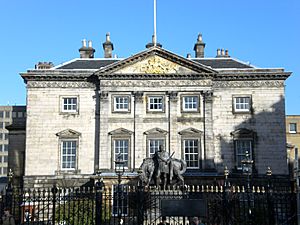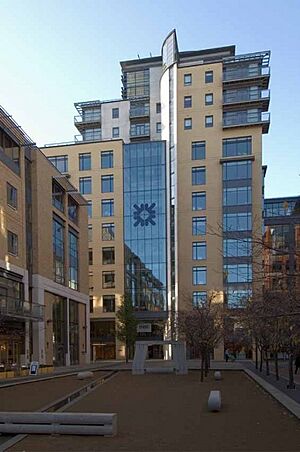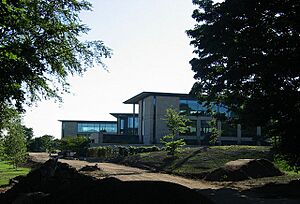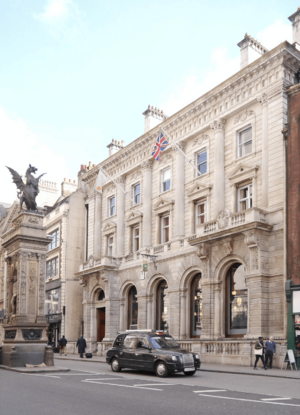NatWest Group facts for kids
 |
|

NatWest Group Registered Office in October 2007
|
|
|
Formerly
|
|
|---|---|
| Public | |
| Traded as |
|
| Industry | |
| Founded | 25 March 1968 |
| Headquarters | Edinburgh, Scotland, UK |
|
Area served
|
United Kingdom |
|
Key people
|
|
| Products |
|
| Revenue | |
|
Operating income
|
|
| Total assets | |
| Total equity | |
|
Number of employees
|
60,700 (2024) |
| Subsidiaries |
|
NatWest Group plc is a big British company that offers banking and insurance services. Its main office is in Edinburgh, Scotland.
This group runs many different banking brands. They offer services for individuals and businesses. These include everyday banking, private banking for wealthy clients, and investment banking. They also provide insurance and help companies with their finances. In the United Kingdom, some of their main companies are National Westminster Bank, Royal Bank of Scotland, NatWest Markets, and Coutts. The group even prints its own banknotes in Scotland and Northern Ireland.
Before a big financial problem in 2008, NatWest was briefly the largest bank in the world. For a while, it was the second-largest bank in the UK and Europe. It was also the fifth-largest globally based on its total value in the stock market. After the financial crisis, its share price dropped a lot. The bank received help from the UK government in 2008. The government owned most of the bank until March 2022. The government sold its last shares on May 30, 2025.
Besides being listed on the London Stock Exchange, the company's shares are also traded on the New York Stock Exchange.
Contents
The History of NatWest Group
How the Royal Bank of Scotland Group Started
In the late 1960s, banks faced tougher economic times. To deal with this, the National Commercial Bank of Scotland joined with the Royal Bank of Scotland. This merger created a new main company called the National and Commercial Banking Group in 1968. The merger became official in 1969. This main company was later renamed The Royal Bank of Scotland Group in 1979. It became a public company, meaning its shares could be bought and sold by anyone, in 1982.
In the late 1990s, many financial companies started joining together. In 1999, the Bank of Scotland tried to take over National Westminster Bank. The Bank of Scotland planned to sell off many of NatWest's smaller companies. However, the Royal Bank of Scotland then made its own offer. This started the biggest takeover battle in UK business history. The Royal Bank of Scotland promised to keep all of NatWest's companies. Even though NatWest was much bigger, it had not been doing well financially.
On February 11, 2000, The Royal Bank of Scotland won the takeover battle. It became the second-largest banking group in the UK. The NatWest brand continued to exist. However, many office jobs were combined, leading to over 18,000 job changes across the UK.
Growing Bigger
In August 2005, the bank expanded into China. It bought a 10% share in the Bank of China for £1.7 billion. It sold these shares by 2009.
In 2005, the bank built a new main office for its international business. It was located at Gogarburn near Edinburgh. Queen Elizabeth II and Prince Philip, Duke of Edinburgh officially opened it.
In October 2007, the group joined with two other banks, Fortis and Banco Santander. Together, they bought the Dutch bank ABN AMRO. Some people thought RBS paid too much for the bank. However, RBS pointed out that its share of the £49 billion cost was only £10 billion.
Later, the bank announced it would reduce its international presence. The Chief Executive, Ross McEwan, explained that the goal was no longer to be the biggest bank in the world. Instead, the bank wanted to focus on serving customers in the UK.
The 2008 Financial Challenges
In April 2008, RBS announced a plan to raise £12 billion. This money was needed to cover losses from credit markets. It also helped strengthen the bank after buying ABN AMRO. This was the largest fundraising effort by a British company at that time.
The bank also said it might sell some of its smaller companies. These included its insurance businesses, Direct Line and Churchill. Also, Tesco bought RBS's share in Tesco Bank for £950 million in 2008.
In October 2008, the British Government decided to help the bank. The government took a share of up to 58% in the group. This was to provide new funds to UK banks. The goal was to help them recover and continue lending money.
The government put £37 billion into Royal Bank of Scotland Group, Lloyds TSB, and HBOS. This was to prevent a major financial collapse. The government said it was not a permanent takeover. They expected the banks to return to private ownership later.
As a result of this help, the chief executive, Fred Goodwin, resigned. Sir Tom McKillop also stepped down as chairman. Stephen Hester took over as chief executive in November 2008.
In January 2009, the British Government announced more funds for the UK banking system. This was to encourage lending to people and businesses. The government also converted its special shares in RBS into regular shares. This increased the government's ownership in the bank from 58% to 70%.
RBS also announced a large loss for the year. This was mainly due to the purchase of ABN-AMRO. The total loss was £24.1 billion, the biggest annual loss in UK corporate history. The bank's share price dropped sharply.
Changes from 2008 Onwards
RBS sold its remaining shares in the Bank of China in January 2009. This decision was made to focus on the British market.
In September 2009, RBS and NatWest made big cuts to their overdraft fees. This included fees for unpaid items and using cards incorrectly. These changes came after public pressure about bank charges.
In November 2009, RBS announced plans to cut 3,700 more jobs. This was in addition to 16,000 jobs already planned. The government also increased its ownership in the company to 84%.
In December 2009, the RBS board disagreed with the government. They wanted to pay £1.5 billion in bonuses to staff.
In late 2010, over 100 senior bank executives at RBS were paid more than £1 million. Total bonuses reached nearly £1 billion. This happened even though the bank reported losses of £1.1 billion for 2010. The CEO, Stephen Hester, received £8 million in payments. Many people questioned these payments since the government owned most of the bank.
In October 2011, Moody's, a company that rates financial strength, lowered RBS's credit rating. They said the bank was financially weak.
In January 2012, there was a public discussion about Stephen Hester's bonus. He was offered shares worth £963,000. These would be paid if he met tough goals. After much criticism, Hester decided to turn down his bonus.
In June 2012, a problem with a computer system upgrade caused many customers to be unable to move money. RBS had to open some branches on a Sunday to help customers. This was the first time they had done this.
In June 2013, RBS announced that CEO Stephen Hester would step down in December 2013. This was part of a plan for the bank to return to private ownership. Ross McEwan, who led retail banking, was chosen to replace Hester.
The UK government began selling its shares back to private investors in August 2015. By June 2018, the government's ownership was reduced to 62.4%.
Making Changes to the Bank
In June 2008, RBS sold its company Angel Trains for £3.6 billion. This was part of a plan to raise money.
In March 2009, RBS closed its department that helped avoid taxes. This department had helped the bank avoid £500 million in taxes. The closure was partly because the bank needed funds and because the government owned most of it.
In January 2012, the bank announced it would cut 4,450 jobs. It also closed some of its less profitable businesses. This brought the total number of jobs cut since the 2008 financial help to 34,000.
In 2012, RBS separated its insurance business to form the Direct Line Group. This group included well-known brands like Direct Line and Churchill. RBS sold off its shares in this group over time, finishing in February 2014.
In October 2015, RBS sold its remaining shares in Citizens Financial Group.
Williams & Glyn Sale Plan
When the British Government bought a large share in RBS, the European Commission said RBS had to sell part of its business. This was because the government's help was seen as "state aid." In August 2010, RBS agreed to sell 318 branches to Santander UK. However, Santander later pulled out of the deal in October 2012.
In September 2013, RBS agreed to sell 314 branches to a group of investors. These branches would become a separate bank, using the old Williams & Glyn's brand. This new bank was planned to focus on ethical banking.
In August 2016, RBS canceled the plan to make Williams & Glyn a separate business. They said the new bank could not survive on its own. Instead, they would try to sell the operation to another bank.
In February 2017, the government suggested that RBS should stop trying to sell the operation. Instead, they should focus on helping more competition in business banking in the UK. This plan was approved in September 2017.
2020 Name Change
On February 14, 2020, it was announced that RBS Group would change its name to NatWest Group. This was because most of its business was already known by the NatWest brand. The change officially happened on July 23, 2020. The government sold its final shares in the business on May 30, 2025.
The government continued to sell its shares in NatWest. In March 2021, its holding was reduced to 59.8%. By May 2023, it was down to 38.6%. By February 2024, the government's ownership was 34.96%. In March 2024, it fell to 29.82%. On May 31, 2024, the government sold more shares back to NatWest, bringing its ownership down to 22.5%. By late July 2024, it was 19.97%. On November 11, 2024, the government sold another £1 billion of shares, reducing its holding from 14.2% to 11.4%. By mid-December 2024, it was 9.99%.
On May 30, 2025, the government sold its very last shares. This meant the NatWest Group was fully owned by private investors again for the first time since 2008.
How NatWest Group is Organized
NatWest Group is divided into four main parts that serve customers. It also has many support teams.
Banking for Everyday People
The NatWest Holdings part includes the bank's services for individuals. It operates in the United Kingdom and the Republic of Ireland. It uses the names NatWest, Royal Bank of Scotland, and Ulster Bank. Key companies in this part are:
Private Banking Services
This part of the bank serves customers who have a lot of money. The main private banking companies and brands of NatWest Group in this area are Coutts, Drummonds Bank, and NatWest and RBS Premier Banking.
Business and Company Banking

This part serves businesses and companies in the UK. This ranges from small and medium-sized businesses to large international companies based in the UK. It is the biggest provider of banking, finance, and risk management services to these customers. It also includes Lombard, which helps businesses finance their assets.
NatWest Markets is the part of NatWest Group that deals with investment banking. It offers financial solutions to large companies and financial groups worldwide. NatWest Markets is strong in helping with debt, managing risks, and providing investment advice. NatWest Markets Securities is a key company in this area, operating in the United States.
The Royal Bank of Scotland International, also known as NatWest International, RBS International, Coutts Crown Dependencies, and Isle of Man Bank, is the part of NatWest Group that handles offshore banking. It offers many services to individuals, businesses, and large companies from its base in the Channel Islands.
Support Teams
The group has many teams that support its operations. These include teams for buying supplies, technology, payments, and property. There are also teams that provide core services across the bank. These include human resources, legal, and risk management.
Who Leads NatWest Group
- Chairman: Richard Haythornthwaite (since April 2024)
- Chief Executive: Paul Thwaite (since February 2024)
- Chief Financial Officer: Katie Murray (since January 2019)
- Chief Governance Officer & Company Secretary: Jan Cargill (since August 2019)
Other Board Members
- Mark Seligman (Senior independent director; since January 2018)
- Frank Dangeard (Independent non-executive director; since May 2016)
- Roisin Donnelly (Independent non-executive director; since October 2022)
- Patrick Flynn (Independent non-executive director; since June 2018)
- Geeta Gopalan (Independent non-executive director; since July 2024)
- Yasmin Jetha (Independent non-executive director; since April 2020)
- Stuart Lewis (Independent non-executive director; since April 2023)
- Gill Whitehead (Independent non-executive director; since January 2025)
- Lena Wilson (Independent non-executive director; since January 2018)
Past Chairmen
- Sir James Blair-Cunynghame (1969–1978)
- Sir Michael Herries (1978–1991)
- Lord Younger (1991–2001)
- Sir George Mathewson (2001–2006)
- Sir Tom McKillop (2006–2008)
- Sir Philip Hampton (2009–2015)
- Sir Howard Davies (2015–2024)
Past Chief Executives
Before 1976, the group was a main company with no direct power. The role of managing director was created in 1976. It was renamed group chief executive in 1985.
- John Burke (1976–1982)
- Sid Procter (1982–1985)
- Charles Winter (1985–1991)
- Sir George Mathewson (1992–2001)
- Fred Goodwin (2001–2008)
- Stephen Hester (2008–2013)
- Ross McEwan (2013–2019)
- Dame Alison Rose (2019–2023)
More to Explore
- List of banks in the United Kingdom
- List of systemically important banks
- Systemically important financial institution
- Inter-Alpha Group of Banks



